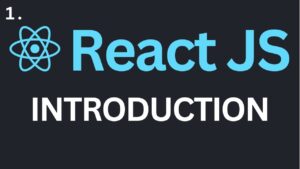Introduction:
In the ever-evolving landscape of web development, React.js has emerged as a game-changer, revolutionizing the way developers build user interfaces. Developed and maintained by Facebook, React.js is an open-source JavaScript library designed to simplify the process of creating interactive and dynamic user interfaces. If you’re just starting your journey into web development, this guide will provide you with a comprehensive introduction to React.js and its fundamental concepts.

Understanding React.js
1. Declarative UI: At the core of React.js is the concept of a declarative user interface. Unlike traditional imperative programming, where developers specify each step for the computer to execute, React allows developers to declare what they want, and the library takes care of the how. This approach simplifies the code, making it more readable and maintainable.
2. Components: React.js applications are built using components – reusable, self-contained units that encapsulate a specific piece of functionality and its corresponding UI. Components can be simple, like a button, or complex, like an entire form. This modular structure fosters code reusability and maintainability.
3. Virtual DOM: One of React’s key performance optimizations is the virtual DOM. Instead of directly manipulating the browser’s DOM, React.js creates a lightweight, in-memory representation of the actual DOM. This virtual DOM allows React to efficiently update only the necessary parts of the UI, minimizing the impact on performance.
4. JSX (JavaScript XML): React.js uses a syntax extension called JSX, which allows you to write HTML within your JavaScript code. This syntax might seem unconventional at first, but it significantly enhances the readability of your components. JSX gets transpiled into standard JavaScript, ensuring compatibility with browsers.
Setting Up Your Development Environment
1. Node.js and npm: React.js applications are typically created and managed using Node.js and npm (Node Package Manager). Ensure you have them installed on your machine to get started.
2. Create React App: Facebook provides a tool called Create React App, which simplifies the process of setting up a new React project. Run a single command to create a new React app and start building without worrying about configuration.
npx create-react-app my-react-app
cd my-react-app
npm start
Building Your First React.js Component
Let’s create a simple React component to display a greeting:
// src/components/Greeting.js
import React from 'react';return <h1>Hello, React!</h1>;
};
Incorporating Components into Your App
// src/App.js
import React from 'react';
import Greeting from './components/Greeting';return (
<div>
<Greeting />
</div>
);
};
Running Your React App
npm start
Visit http://localhost:3000 in your browser to see your first React app in action.
Conclusion:
React.js is a powerful and versatile library that has transformed the way developers approach building user interfaces. This guide has provided you with a foundational understanding of React’s key concepts, helping you embark on your journey to becoming a proficient React developer. As you delve deeper into React.js, explore its extensive documentation and vibrant community to unlock the full potential of this cutting-edge technology. Happy coding!
